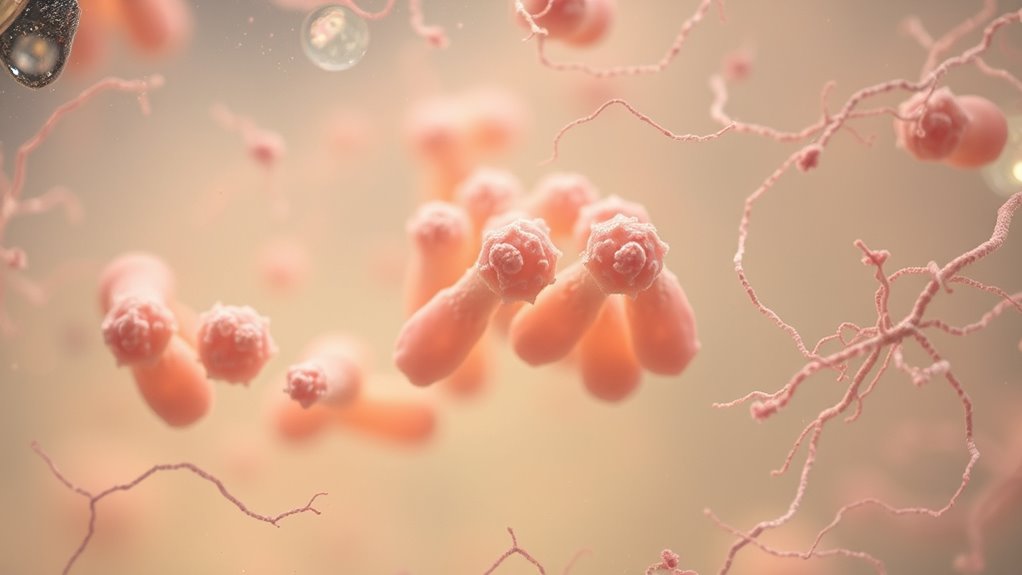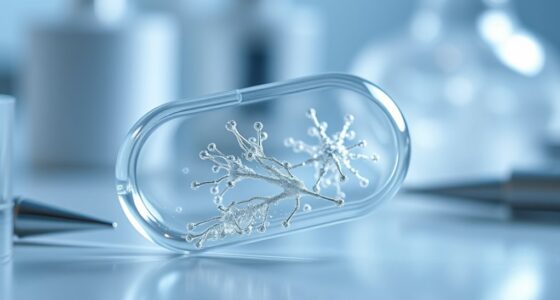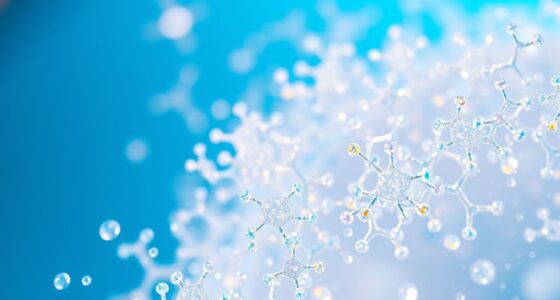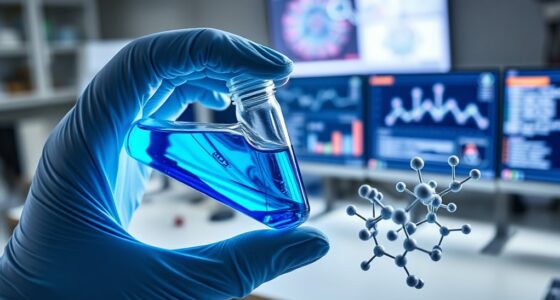You should know that bacteria constantly evolve molecular tricks to beat antibiotics, making treatments less effective. They develop resistance by producing enzymes that destroy drugs, changing target sites so antibiotics can’t bind, and using pumps to actively remove the medications. These strategies allow bacteria to survive even when antibiotics are used correctly. If you want to understand how these clever advances work and what can be done, there’s more to uncover about bacterial resistance mechanisms.
Key Takeaways
- Bacteria develop enzymes like beta-lactamases that break down antibiotics, rendering them ineffective.
- They modify target sites so antibiotics can no longer bind and inhibit bacterial functions.
- Efflux pumps actively remove antibiotics from bacterial cells, reducing drug efficacy.
- Horizontal gene transfer spreads resistance genes across bacterial populations rapidly.
- These molecular tricks allow bacteria to survive antibiotic treatment and cause persistent infections.

Antibiotics are powerful medicines that target bacteria, helping you fight infections and recover faster. However, bacteria aren’t passive victims; they constantly adapt through mechanism evolution, which enables them to evade these drugs. When you take an antibiotic, you’re applying selective pressure on bacteria, and some may have or develop resistance pathways that allow them to survive despite the medication.
Bacteria constantly adapt through mechanism evolution, developing resistance pathways to survive antibiotic treatment.
This process of mechanism evolution involves genetic changes—mutations or gene acquisitions—that alter bacterial structures or functions, rendering antibiotics ineffective. Over time, these changes accumulate, producing resistant strains that can withstand treatments that once worked.
Resistance pathways are the specific routes bacteria take to evade antibiotics. Some bacteria produce enzymes like beta-lactamases that break down antibiotics before they can act. Others modify their target sites—such as altering penicillin-binding proteins—so the drug no longer binds effectively. Still, some bacteria develop efflux pumps, which actively expel antibiotics from their cells, reducing the drug’s concentration to ineffective levels.
These resistance pathways aren’t random; they’re driven by the bacteria’s ability to adapt rapidly and are often facilitated by horizontal gene transfer, where bacteria exchange genetic material, including resistance genes, with each other. This exchange accelerates the spread of resistance across different bacterial populations and species.
Understanding the mechanism evolution behind resistance pathways highlights why some antibiotics fail. When bacteria evolve new mechanisms or enhance existing ones, they can bypass the drug’s mode of action entirely. For example, the evolution of enzymes that degrade antibiotics or modifications to binding sites effectively neutralize the drug’s impact.
These changes can happen quickly, especially under the selective pressure of widespread antibiotic use, leading to resistant infections that are harder to treat. Consequently, antibiotics that once cleared infections are now losing their efficacy, forcing healthcare providers to turn to stronger, more toxic, or more expensive alternatives.
In essence, bacteria’s ability to evolve mechanisms and resistance pathways is a testament to their adaptability. It underscores the importance of prudent antibiotic use and ongoing research to develop new drugs that can circumvent these bacterial defenses.
Understanding the role of genetic changes in bacterial adaptation emphasizes why maintaining responsible antibiotic stewardship is critical. Without understanding these molecular tricks, we risk losing critical tools in the fight against bacterial infections, and infections that were once easily treatable may become deadly. Recognizing how bacteria adapt helps you appreciate the urgency of combating resistance and supports efforts to preserve antibiotic effectiveness for future generations.
Frequently Asked Questions
How Do Bacteria Develop Resistance so Quickly?
Bacteria develop resistance quickly through genetic mutations, which happen randomly and can alter drug targets. They also use horizontal transfer, sharing resistance genes with other bacteria via plasmids or viruses.
This rapid exchange and mutation allow bacteria to adapt fast, making antibiotics less effective. Your understanding of these mechanisms shows how bacteria swiftly evolve, posing a serious challenge to infection treatment and emphasizing the need for prudent antibiotic use.
Can Antibiotic Resistance Be Reversed?
You might wonder if antibiotic resistance can be reversed. While some resistance mechanisms result from genetic mutations, reversing them isn’t easy because bacteria can pass these mutations quickly.
Reducing antibiotic use can slow resistance development, but reversing existing resistance often requires innovative strategies like developing new drugs or targeting resistance mechanisms directly.
Ultimately, preventing resistance is more achievable than reversing it once it has established itself.
What Role Do Hospitals Play in Resistance Spread?
Imagine a patient with a resistant infection, then transfer it to others. Hospitals play a big role in resistance spread through lapses in hospital hygiene, which can lead to patient transmission of drug-resistant bacteria.
When hygiene isn’t strict, bacteria spread easily, making infections harder to treat. Your role in supporting proper hygiene can help reduce this spread, protecting both patients and the wider community from resistant infections.
Are There Natural Alternatives to Antibiotics?
You might wonder if natural alternatives to antibiotics exist. While some believe herbal solutions and alternative remedies can help fight infections, they’re not always verified effective against serious bacterial infections.
You should be cautious and consult healthcare professionals before relying on these options. Although herbal solutions may support immunity, they shouldn’t replace antibiotics when prescribed, especially in severe cases, to ensure proper treatment and avoid resistance development.
How Do Bacteria Communicate to Share Resistance?
Imagine bacteria as tiny towns, where they whisper secrets through quorum sensing to coordinate their defenses. They share resistance info and build biofilms, like fortresses, making antibiotics less effective.
Through this communication, bacteria unite, strengthening their survival. Quorum sensing acts as their secret language, enabling them to adapt quickly.
Understanding this process helps us find ways to break their code and combat resistance more effectively.
Conclusion
Understanding how bacteria outsmart antibiotics is like catching a thief in the act—you need to know their tricks to stop them. By learning their molecular tricks, you can stay one step ahead and develop smarter treatments. Stay curious and vigilant, because fighting drug resistance is a race against time. Remember, the bacteria might be clever, but with the right knowledge, you can outwit them and keep your defenses strong.









